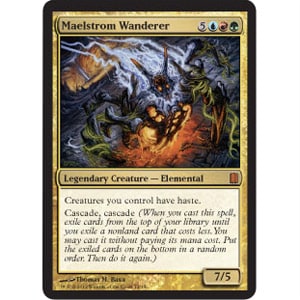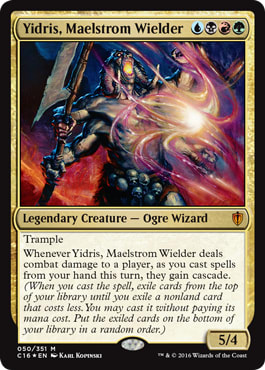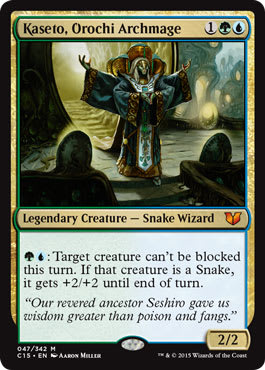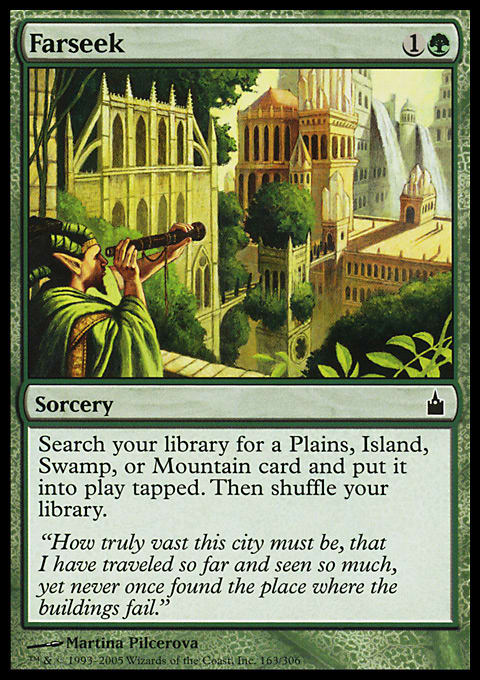This series has been going for a while and I’ll be honest — I never really envisioned going this long or learning so much about a thing that was born of an off-handed conversation I had with Adam Styborski years ago. In fact, this series has been running so long I basically forgot all about one of the first tenets I came up with because it wasn’t quite fleshed-out enough to ever really become an actual rule. If you remember how this series began, I posted one of the decks I had already created and then tried to see if there was something unique about the way I built that I could try and codify so that it could be applied to other decks. One of the first decks I posted was my Maelstrom Wanderer deck, a deck that I have since decided I didn’t want to have built 75% anymore. My thoughts after looking at a deck like that were that you could do powerful things without your opponents blaming you too much for what happened if it appeared to be random. That was perhaps a naive view of the way people feel about cascade because you’re always getting card advantage even if the card you rip off of the top isn’t ideal. Also, it can be sort of easy to juice it so your cascade always benefits you; you can run cards like Scroll Rack or you can make sure you always hit the right target by making sure the only spell small enough to cascade into is the right one (Seismic Assault again? I must be the luckiest guy on earth! Anyway, I’ll hit my swans 10 times and draw my deck then kill you.) This was the genesis of the “skew toward power if you want as long as you skew away from consistency” idea. Remember, a deck has to be able to win to be 75%, but it shouldn’t win every single game.
We found other ways to skew toward being a little less consistent and haven’t looked back, that is until they gave us another cascade commander. This brought back some fond memories of wandering all over the maelstroms and hitting the exact card I needed off of a lucky cascade. Could we revisit the concept about skewing away from consistency with a commander like Yidris, Maelstrom Wielder? More importantly, how stoked am I to be able to play Black and have access to cards like Tasigur, the Golden Fang, Deathrite Shaman, and Consuming Aberration (Very). Is your deck sufficiently inconsistent when every card you can possibly cascade into is gas? What about when you can’t do your stupid Food Chain shenanigans but rather have to rely on being able to deal your opponent some damage? Will that attenuate the power level of the deck enough that we’re just going to get stupid card advantage but won’t be able to combo off and will thereby approach our 75% sweet spot?
I feel like the way I want to take advantage of being able to cast spells and make them cascade is to play a lot of delve cards if I can. This lets me cast them for cheaper and play more spells in a turn where I managed to hit them with Yidris and lets me pay 1 mana for Treasure Cruise that can cascade into a Maelstrom Wanderer. That’s what I call living the dream. However, I’m going to try to avoid building the typical, basic Yidris builds I keep seeing which use wheel effects to keep your Graveyard full. Instead, I’m going to try and use spells that steal their stuff which in turn will hopefully cascade into more ways to steal their stuff. All of a sudden Enslave doesn’t look like a bad deal if you can cascade into a Treachery. We’ll want to hit them often because when we do that, we can get multiple cascades from the same spell because his ability stacks if you use Grappling Hook or Relentless Assault. Add in a few ways to make sure Yidris connects and you got a stew, baby! How is our deck going to look when we build hoping that the act of randomly cascading into spells can give us advantage without the appearance that we’re anything but lucky?
Better lucky and good than just good ? Commander | Jason Alt
- Commander (1)
- 1 Yidris, Maelstrom Wielder
- Creatures (22)
- 1 Acidic Slime
- 1 Birds of Paradise
- 1 Bloodbraid Elf
- 1 Coiling Oracle
- 1 Dragonlord Atarka
- 1 Etherium-Horn Sorcerer
- 1 Greenwarden of Murasa
- 1 Grinning Ignus
- 1 Inferno Titan
- 1 Kaseto, Orochi Archmage
- 1 Kozilek, Butcher of Truth
- 1 Maelstrom Wanderer
- 1 Marchesa's Smuggler
- 1 Oracle of Mul Daya
- 1 Peregrine Drake
- 1 Rashmi, Eternities Crafter
- 1 Siege Behemoth
- 1 Stonehoof Chieftain
- 1 Sylvan Caryatid
- 1 Ulamog, the Infinite Gyre
- 1 Utopia Tree
- 1 World Breaker
- Planeswalkers (1)
- 1 Nicol Bolas, Planeswalker
- Spells (35)
- 1 Dig Through Time
- 1 Krosan Grip
- 1 Murderous Cut
- 1 Blasphemous Act
- 1 Bribery
- 1 Decimate
- 1 Farseek
- 1 Recurring Insight
- 1 Rude Awakening
- 1 Seasons Past
- 1 Treasure Cruise
- 1 Volcanic Vision
- 1 Aggravated Assault
- 1 Bear Umbra
- 1 Cyclonic Rift
- 1 Enslave
- 1 Mind's Dilation
- 1 Nature's Will
- 1 Rage Reflection
- 1 Temur Ascendancy
- 1 Treachery
- 1 Zendikar Resurgent
- 1 Chromatic Lantern
- 1 Commander's Sphere
- 1 Darksteel Ingot
- 1 Fireshrieker
- 1 Grappling Hook
- 1 Gruul Signet
- 1 Izzet Signet
- 1 Mana Vault
- 1 Simic Signet
- 1 Sol Ring
- 1 Swiftfoot Boots
- 1 Temur Banner
- 1 Whispersilk Cloak
- Lands (39)
- 1 Mountain
- 1 Swamp
- 2 Forest
- 2 Island
- 1 Arcane Lighthouse
- 1 Blood Crypt
- 1 Breeding Pool
- 1 Cascade Bluffs
- 1 City of Brass
- 1 Command Beacon
- 1 Command Tower
- 1 Crumbling Necropolis
- 1 Exotic Orchard
- 1 Frontier Bivouac
- 1 Golgari Rot Farm
- 1 Gruul Turf
- 1 Izzet Boilerworks
- 1 Kessig Wolf Run
- 1 Mana Confluence
- 1 Opal Palace
- 1 Opulent Palace
- 1 Overgrown Tomb
- 1 Reflecting Pool
- 1 Reliquary Tower
- 1 Rogue's Passage
- 1 Rupture Spire
- 1 Simic Growth Chamber
- 1 Steam Vents
- 1 Stomping Ground
- 1 Temple of Abandon
- 1 Temple of Deceit
- 1 Temple of Epiphany
- 1 Temple of Malady
- 1 Temple of Malice
- 1 Temple of Mystery
- 1 Temple of the False God
- 1 Watery Grave
This ended up pretty dissimilar from a lot of stock lists and I’m reasonably happy with that. I didn’t add Wheel of Fortune effects because while they made my few spells with Delve better, it wasn’t worth it and I didn’t have enough anyway. I initially set out to run lots of delve and flashback spells but I ended up not having room. I wanted to run Worm Harvest and Call the Skybreaker, also, but they didn’t really synergize that well with anything. I’m not going to be dumping that much in the yard, anyway, and paying a lot of mana for a spell that doesn’t trigger cascade didn’t seem worth it.
What did seem worth it was getting the most of out hitting them with my commander. I ran a few ways to make him unblockable so I could count on hitting them first of all. The spells in your hand get a lot better when they have cascade. Since we have to work for our cascade triggers in this build, let’s make sure we can get them often, and cards like Kaseto, Orochi Archmage and Whispersilk Cloak make that a reality. Once we are hitting them, Fireshrieker and Rage Reflection type effects give us multiple stacks so when we cast spells, they’ll cascade more than once. That will give us a ton of advantage.
I saw a lot of obvious combo potential and eschewed most of it. If you play this deck and find it could use a little juice to win, it’s worth knowing about some of the stuff I cut so you can add it back in. I left in Treachery and Peregrine Drake because they synergize nicely with Gruul Turf lands, but cut out Palinchron. You can get pretty degenerate with that combo, allowing you to pay 4 mana to cascade as often as you can cough up the mana, and perhaps go infinite with enough lands that produce more than 1 mana. If you need that much power, know it’s there, but I think you shouldn’t need that to win 1/x games (where x is the number of players) like we strive for in a 75% build. One combo I did include was Grinning Ignus. Since Ingus has a low cost, you’ll be cascading into mana creatures and mana rocks and this is an excellent way to thin your deck out and make your later cascades better without doing anything truly degenerate and painting a target on your back. Do it as much as you can to get a pile of Signets and mana dorks that make your later spells easier to cast.
The spells in the deck are on the expensive side so this deck may start out slow, but there are enough mana rocks and dorks that this shouldn’t be too much of an issue. You can summon your commander on 4 mana and get started even if you’re only casting a Farseek post-combat to cascade into Sol Ring. This deck will snowball a lot more than the traditional Maelstrom Wanderer decks, but that’s because it almost has to. Once you hit 7 or 8 mana, the real fun begins.
I cut Godo, Bandit Warlord because even though he’s a pretty benign tutor, I felt like I didn’t have room. I had to make about 15 cuts to this deck which is more than normal and I cut deep. Godo would be a good guy to add back in if you find some room. I cut Darksteel Plate, also (I like Stonehoof Chieftain better) but Godo can find Grappling Hook or Swiftfoot Boots. However, this isn’t a Voltron deck so I decided not to have too many cards just serve the commander. However, if you find you’re having too much trouble keeping Yidris alive, look at Darksteel Plate as a possibility, and if you’re not connecting as often as you like, give Key to the City a try. That fills your yard and lets you connect and it’s almost perfect for the deck.
All in all I am happy with this first draft of the deck. You can customize this to make it yours, but just know that it’s more fun to build a version of Yidris that doesn’t look exactly like everyone else’s, and as long as you’re cascading semi-randomly (with the exception of our Grinning Ignushenanigans, which I fully endorse), you’re going to end up with fun situations that are not your fault and shouldn’t get you dogpiled by opponents. They don’t have to know your deck is full of gas and any card you cascade into is going to be a real beating. Just remember to hit them early and often with Yidris and let your deck do the rest. I’ll be back in a week’s time with more shenanigans but feel free to tide yourself over by commenting on, liking and sharing this article. Until next week!


























